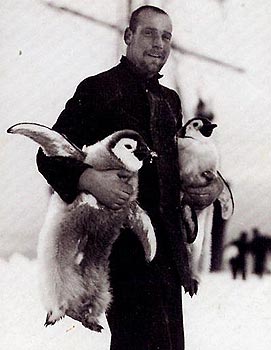One stinging truth the study revealed was quite obvious: most heroes tend to die. Scott, Shackleton, Franklin, and my favourite, Titus Oates – who spoke the immortal last words – “I’m just going outside and may be some time”, all perished. But is it the actions of a person, or their last words that make them a hero? Or perhaps, heroism is in what that person eats while they are alive. Certainly one can’t be heroic without food. As the saying goes, it may very well be ‘in the water’…
Polar explorers would pretty much eat anything they could get their hands on. The most successful polar explorers, like Amundsen, would be ruthless with food. In 1911, it was food that played the pivotal role in survival, as Scott and Amundsen raced to the south pole. Scott with his ponies (quiet chuckle from me. Ponies, in Antarctica!) and Amundsen with his dogs. It is the same on any polar expedition; without sufficient food, the cold gets colder, and the hungry body, using considerably more calories than usual, doesn’t fix itself as it should, and energy levels plummet.
“Polar explorers would pretty much eat anything they could get their hands on.”
It was on the return from the South pole expedition that Scott died and wrote his letter telling the world about his heroic tale. Amundsen didn’t die, he won the race to the south pole and, rather than writing a letter about it, he got home to tell the story. How did he succeed? He ate his dogs. One by one as his load got lighter and less kit was needed or used for the expedition, fewer dogs were required to pull the load and those dogs were looked upon as a commodity – breakfast, lunch and dinner – rather than man’s best friend. Smart, but rather macabre. Of course Scott ate his ponies, while they were still able to endure the polar environment, which wasn’t for long.
“As fewer dogs were required to pull the load, those dogs were looked upon as breakfast, lunch and dinner.”
Scott needed roughly an additional 2000-3000 calories every day than his biscuits and dried beef could provide him with. Perhaps if Scott would have packed food that could survive, and walk on its own four legs in Antarctica, he may have won the prize of the pole.
Amundsen also turns up in the north. Ten years before he conquered the south pole, he humiliated the Brits by taking a very small boat along the Northwest Passage and becoming the first man to successfully navigate between the Atlantic and Pacific oceans.
One of the British men that Amundsen beat was Franklin, another polar hero, who died in his Northwest Passage attempt. Franklin, with his large, technologically advanced vessels HMS Erebus and HMS Terror, had packed what he believed to be his guarantor to the expedition’s success: canned food – a revolutionary packaging which would keep his men fed for years on fresh grub. Or so he thought, except that unfortunately the solder that welded the freshness in was lead, which eventually caused lead poisoning and made most of his men go a bit mad before dying. Amundsen, on the other hand, hung out with the Inuits and learned how they hunted and survived in the Canadian wilderness, (there is rumour that he even fathered an Inuit child, which he vehemently denied). Amundsen was a smart cookie.
Shackleton’s Endurance is a story of heroism, possibly the most heroic of them all. At the beginning of the voyage, food stores were ample; filled with biscuits, the finest York Hams, sheep tongues, and of course 25 cases of whisky. However after the Endurance sank to the bottom of the Weddell Sea, crushed by ice floes, food became…different. I want to say scarce, but the reality is that there were plenty of penguins and seals around, for a while any way, and so penguin steak became the staple diet, with a side of seaweed.
“Penguin steak became the staple diet, with a side of seaweed.”
While floating on the sea ice, waiting for rescue that wouldn’t arrive, the Endurance’s crew were attacked by a sea leopard, which Frank Wild quickly shot dead. It was seen as good fortune when the sea leopard was found to have a stomach full of undigested fish which provided a delicious meal for the crew. A chef friend of mine would say something like “make use of what you have” or perhaps “variety is the spice of life”.
Shackleton and all 27 of his men survived almost two years on penguins, seals and seaweed, though food became very scarce when the penguins were hard to find at times. It has been reported that Shackleton was even partial to a little bit of elephant seal snout. If you have ever seen an elephant seal, you will know that’s quite a large meal, and I should imagine more meaty than fat, though I haven’t tried it myself.
“It has been reported that Shackleton was even partial to a little bit of elephant seal snout.”
Shackleton’s Endurance was a remarkable struggle. He eventually died on his next expedition in South Georgia, with his doctor telling him hours before his last breath that he should drink less whiskey.
As the research paper suggested, heros do tend to die. Which leads me to wonder, if it is indeed the food that a person eats that make them heroic? Penguin rather than lead, seal rather than ponies, a tipple of whiskey on the side? Of course by the looks of things, a little dog goes a long way. I suppose it’s a lot like our modern day balanced diets: get it right and live a long life.


